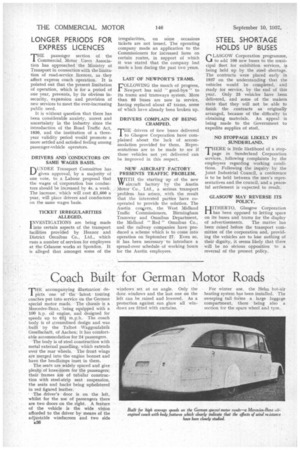coach Built for German Motor Roads
Page 62

If you've noticed an error in this article please click here to report it so we can fix it.
THE accompanying illustration depicts one of the 'latest totiring coaches put into service on the German special motor roads. The chassis is a Mercedes-Benz, being equipped with a 100 h.p. oil engine, and designed for speeds up to 62-i m.p.h. The coach body is of streamlined design and was
• built by the Talbot Waggonfabrik Gesellschaft, of Aachen; it has comfortable accommodation for 24 passengers.
The body is of steel construction with metal external panelling, which extends over the rear wheels. The front wings are merged into the engine bonnet and have the headlamps inset in them.
The seats are widely spaced and give plenty of knee-room for the passengers; their frames are of tubular construction with steel-strip seat suspension, the seats and backs being upholstered in red figured leather.
The driver's door is on the left, whilst for the use of passengers there are two doors on the right. A feature of the vehicle is the wide vision afforded to the driver by means of the adjustable windscreen and two side
windows set at an angle. Only the door windows and the last one on the left can be raised and lowered. As a protection against sun glare all windows are fitted with curtains. For winter use. the Helm hot-air heating system has been installed. The sweeping tail forms a large luggage compartment, there being also a section for the spare wheel and tyre.




























































































